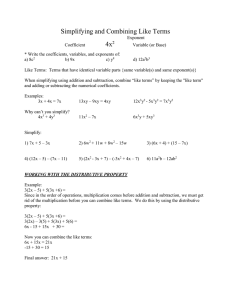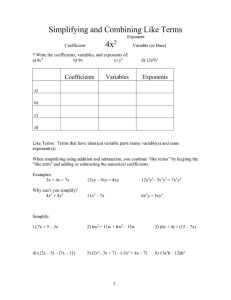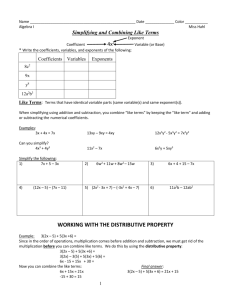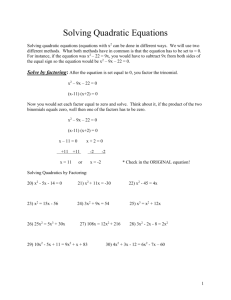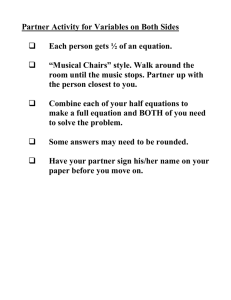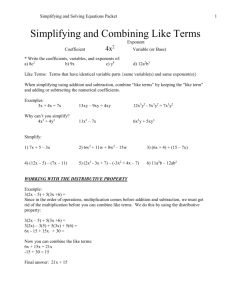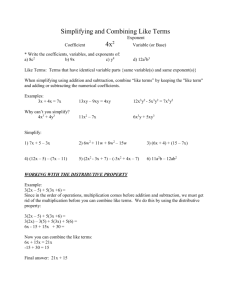Solving Equations
advertisement
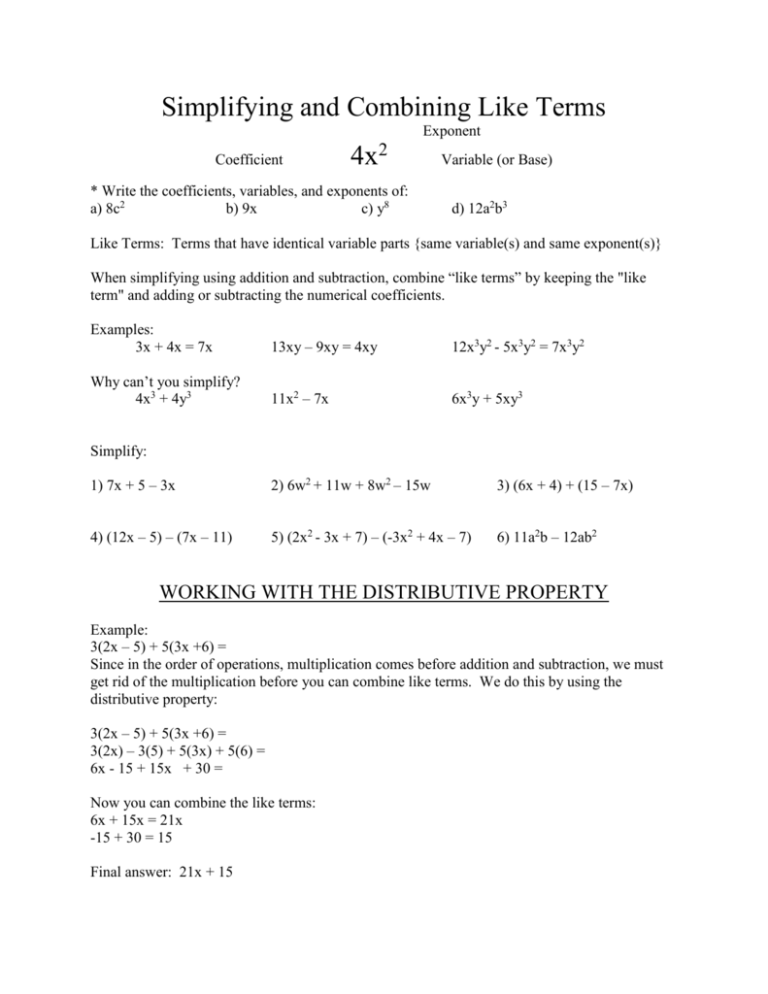
Simplifying and Combining Like Terms
Exponent
Coefficient
4x
2
* Write the coefficients, variables, and exponents of:
a) 8c2
b) 9x
c) y8
Variable (or Base)
d) 12a2b3
Like Terms: Terms that have identical variable parts {same variable(s) and same exponent(s)}
When simplifying using addition and subtraction, combine “like terms” by keeping the "like
term" and adding or subtracting the numerical coefficients.
Examples:
3x + 4x = 7x
13xy – 9xy = 4xy
12x3y2 - 5x3y2 = 7x3y2
Why can’t you simplify?
4x3 + 4y3
11x2 – 7x
6x3y + 5xy3
Simplify:
1) 7x + 5 – 3x
2) 6w2 + 11w + 8w2 – 15w
3) (6x + 4) + (15 – 7x)
4) (12x – 5) – (7x – 11)
5) (2x2 - 3x + 7) – (-3x2 + 4x – 7)
6) 11a2b – 12ab2
WORKING WITH THE DISTRIBUTIVE PROPERTY
Example:
3(2x – 5) + 5(3x +6) =
Since in the order of operations, multiplication comes before addition and subtraction, we must
get rid of the multiplication before you can combine like terms. We do this by using the
distributive property:
3(2x – 5) + 5(3x +6) =
3(2x) – 3(5) + 5(3x) + 5(6) =
6x - 15 + 15x + 30 =
Now you can combine the like terms:
6x + 15x = 21x
-15 + 30 = 15
Final answer: 21x + 15
Solving Equations
Golden Rule of Algebra:
“Do unto one side of the equal sign as you will do to the other…”
Whatever you do on one side of the equal sign, you MUST do the same exact thing
on the other side. If you multiply by -2 on the left side, you have to multiply by -2 on the other.
If you subtract 15 from one side, you must subtract 15 from the other. You can do whatever you
want (to get the x by itself) as long as you do it on both sides of the equal sign.
Solving Single Step Equations:
To solve single step equations, you do the opposite of whatever the operation is. The
opposite of addition is subtraction and the opposite of multiplication is division.
Solve for x:
2) x – 11 = 19
5) (x/-5) = 3
1) x + 5 = 12
4) 5x = -30
3) 22 – x = 17
6) ⅔ x = - 8
Solving Multi-Step Equations:
3x – 5 = 22
To get the x by itself, you will need to get rid of the 5 and the 3.
+5 +5
We do this by going in opposite order of PEMDAS. We get rid
of addition and subtraction first.
3x
3
= 27
3
Then, we get rid of multiplication and division.
x =9
We check the answer by putting it back in the original equation:
3x - 5 = 22, x = 9
3(9) - 5 = 22
27 - 5 = 22
22 = 22 (It checks)
Simple Equations:
1) 9x - 11 = -38
2) 160 = 7x + 6
3) 32 - 6x = 53
4) -4 = 42 - 4x
5) ¾x - 11 = 16
6) 37 = 25 - (2/3)x
7) 4x – 7 = -23
8) 12x + 9 = - 15
9) 21 – 4x = 45
10) (x/7) – 4 = 4
11) (-x/5) + 3 = 7
12) 26 = 60 – 2x
Equations with more than 1 x on the same side of the equal sign:
You need to simplify (combine like terms) and then use the same steps as a multi-step equation.
Example:
9x + 11 – 5x + 10 = -15
4x + 21 = -15
Now it looks like a multistep eq. that we did in the 1 st
-21 -21
Use subtraction to get rid of the addition.
4x
= -36
4
4
Now divide to get rid of the multiplication
9x – 5x = 4x and
11 + 10 = 21
x
13) 15x - 24 - 4x = -79
= -9
14) 102 = 69 - 7x + 3x
15) 3(2x - 5) - 4x = 33
16) 3(4x - 5) + 2(11 - 2x) = 43
17) 9(3x + 6) - 6(7x - 3) = 12
18) 7(4x - 5) - 4(6x + 5) = -91
19) 8(4x + 2) + 5(3x - 7) = 122
Equations with x's on BOTH sides of the equal sign:
You need to "Get the X's on one side and the numbers on the other." Then you can solve.
Example: 12x – 11 = 7x + 9
-7x
-7x
5x – 11 = 9
+11 +11
5x
= 20
5
5
x
Move the x’s to one side.
Now it looks like a multistep equation that we did in the 1 st section.
Add to get rid of the subtraction.
Now divide to get rid of the multiplication
=4
20) 11x - 3 = 7x + 25
21) 22 - 4x = 12x + 126
23) ¾x - 12 = ½x -6
24) 5(2x + 4) = 4(3x + 7)
25) 12(3x + 4) = 6(7x + 2) 26) 3x - 25 = 11x - 5 + 2x
Proportions and Percents
Proportions:
A proportion is a statement that two ratios are equal. When trying to solve proportions we use
the Cross Products Property of Proportions.
A = C
A(D) = B(C)
B
D
Example:
6__ = x__
x + 5__ =
1.5___
11
121
12
6
6(121) = 11x
6(x + 5) = 12(1.5)
726 = 11x
6x + 30 = 18
-30
-30
6x
= -12
6
6
x
= -2
726 = 11x
11
11
66 = x
1)
x
14
_
=
16
35
2)
x–3 _ =
x+3
12
30
_
Percents:
Is
=
%___
Of
100
Example:
What number is 20% of 50?
Is:
?x
x
=
20 .
Of:
of 50
50
100
%:
20%
100: 100
100x = 20(50)
100x = 1,000
100x = 1,000
100
100
x = 10
a) What number is 40% of 160?
b) 48 is what percent of 128?
c) 28 is 75% of what number?
d) What number is 36% of 400?
Part I:
1)
x . =
12
18
54
.
2) -
13
x
. =
65
90
.
3) x + 4 . =
9
4) - 16 . =
8 .
6x-2
11
6) What is 20% of 32?
5)
14
. =
16
7) 72 is 40% of what number?
8) 21.56 is what percent of 98?
9) - 31 is what percent of -124?
6x .
18
3x
.
3x + 3
10) What is 62% of 140?
Part II:
1)
x . =
12
13
78
4)
- 16 . =
5x-2
8 .
11
.
2)
- 13
x
5)
x+5
x-3
. =
195
150
. =
x
9
.
3) x + 4 . =
9
.
6)
12
x-4 _ =
x+8
6x .
18
9
_
7) 12 is 40% of what number?
8) 21.56 is what percent of 98?
9) 45 is what percent of 180?
10) What is 62% of 70?
Part III:
1)
23
x
4)
x+1
x+6
.
=
.
57.5
45
=
.
2
x
.
2) 3x – 5 . =
13
5x + 1 .
52
5) 2x – 4 . =
x+5
x-2 .
x+1
10) What is 80% of 850?
8) 128 is 32% of what number?
9) 72 is what percent of 120?
10) What is 80% of 850?
3) 5x -1
10x+5
6) x + 7
2x – 1
= 33 .
45
= x+6 .
x-2
Solving Quadratic Equations
Solving quadratic equations (equations with x2 can be done in different ways. We will use two
different methods. What both methods have in common is that the equation has to be set to = 0.
For instance, if the equation was x2 – 22 = 9x, you would have to subtract 9x from both sides of
the equal sign so the equation would be x2 – 9x – 22 = 0.
Solve by factoring: After the equation is set equal to 0, you factor the trinomial.
x2 – 9x – 22 = 0
(x-11) (x+2) = 0
Now you would set each factor equal to zero and solve. Think about it, if the product of the two
binomials equals zero, well then one of the factors has to be zero.
x2 – 9x – 22 = 0
(x-11) (x+2) = 0
x – 11 = 0
x+2=0
+11 +11
-2
x = 11
x = -2
or
-2
* Check in the ORIGINAL equation!
Solving Quadratics by Factoring:
20) x2 - 5x - 14 = 0
21) x2 + 11x = -30
22) x2 - 45 = 4x
23) x2 = 15x - 56
24) 3x2 + 9x = 54
25) x3 = x2 + 12x
26) 25x2 = 5x3 + 30x
27) 108x = 12x2 + 216
29) 10x2 - 5x + 11 = 9x2 + x + 83
28) 3x2 - 2x - 8 = 2x2
30) 4x2 + 3x - 12 = 6x2 - 7x - 60
Solve using the quadratic formula:
When ax2 + bx + c = 0
x=
-b ± √b2 – 4ac .
2a
a is the coefficient of x2 b is the coefficient of x c is the number (third term)
Notice the ±
is what will give your two answers (just like you had when solving by factoring)
x2 – 9x – 22 = 0
a=1
x=
-b ± √b2 – 4ac .
2a
b= - 9
c = -22
x=
-(-9) ± √ (-9)2 – 4(1)(-22)
2(1)
x=
9 ± √81 + 88
2
x=
9 ± √169 .
2
-4(1)(-22) = 88
Split and do the + side and - side
9 – 13
2
9 + 13
2
x = 11
or
x = -2
* Check in the ORIGINAL equation!
Solving Quadratics Using the Quadratic Formula:
31) 2x2 - 6x + 1 = 0
32) 3x2 + 2x = 3
33) 4x2 + 2 = -7x
34) 7x2 = 3x + 2
35) 3x2 + 6 = 5x
36) 9x - 3 = 4x2
Mixed Equations: Figure out what type of equation you have and then pick a strategy
to solve.
1) 20 - (5/8)x = 40
2) 6(7x - 2) = 8(4x + 1)
3) 2(5x - 4) - 3(4x + 3) = -43
4) x2 + 44 = 15x
5) 3x2 + 18x = 81
6) 3x2 = 5x + 5
7) 11x - 5 = 7x - 53
8) 6(3x + 1) + 5(10 - 4x)= 39
9) ¼x - 33 = -49
10) 7x2 - 1 = 3x
11) 9(3x + 1) = 8(5x + 6)
12) 15x = x2 - 16
13) x2 + 8x = 12
14) 9(4x + 7) - 6(7x + 10) = -54
15) 44 = 20 - 2x
16) 4x2 - 128 = 16x
17) 3x2 - 8x + 6 = x + 6
18) 7(6x + 2) = 10(3x + 5)
19) 3x2 + 13x - 12 = 9x2 - 11x - 12
20) 2x2 - 14 = 10x
